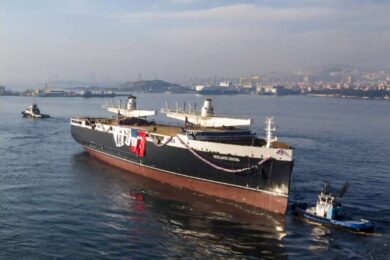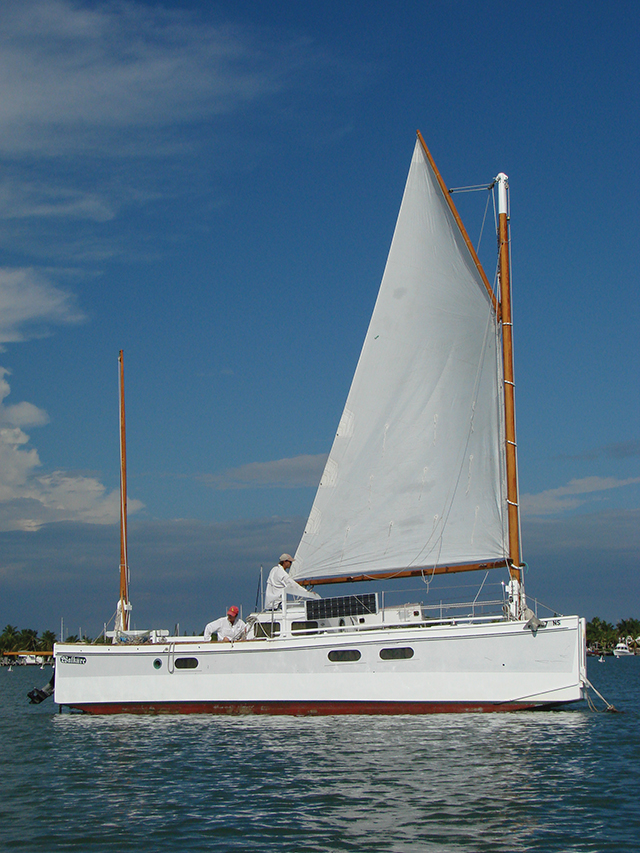After life on the open sea, the confines of cruising the Intracoastal Waterway in a 29-foot sharpie present unexpected challenges (published July 2013)
As the sea buoy dips under the horizon and the last of the buildings shrink to nothing, we allow ourselves to relax. With the occasional ship and fairly predictable weather as our only obstacles, we begin to enjoy the passage. Even Eurisko seems to thrive in a long ocean swell with a stiff breeze. We settle into a routine as our sailing home leads us to our next adventure.
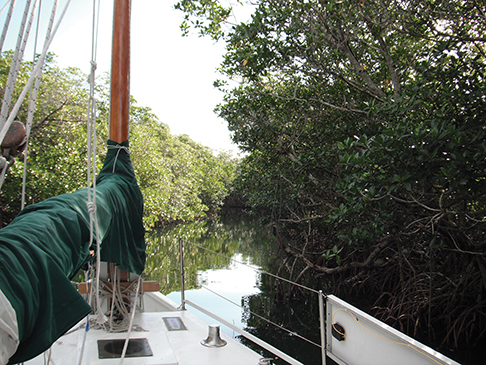
Lately though, our adventure has changed. As our boys grow up there are weddings to attend, graduations to celebrate and a new grandson to spoil. While we’re not done crossing big water, for a year or so we are exchanging our blue water cruising lives for brown-water, Intracoastal Waterway (ICW) trekking, keeping us closer to home and our family. And, to accommodate our change in exploration techniques, we temporarily traded our deep-draft battleship for a plywood box: a Phil Bolger AS-29.
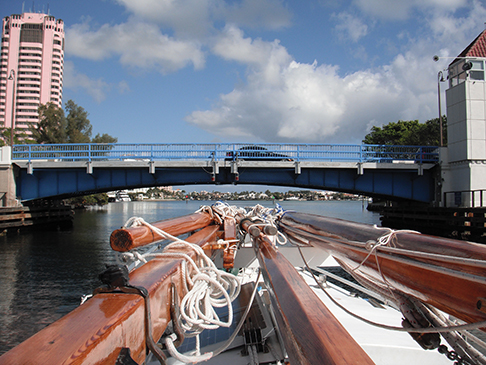
Our little Sharpie draws 13 inches with her bilge boards raised. Her mizzen and gaff rigged masts are on tabernacles, allowing us to lower the rig by hand and motor under 8-foot bridges, which makes transiting those bridge-riddled parts of the ICW much easier. We traveled these waters nearly a decade ago in Eurisko, chasing our Caribbean dream, but in Walküre we are not using the ICW as a simple highway, we are exploring its tributaries and enjoying the gunkholing that wasn’t possible with a five-and-a-half-foot draft.
With 20,000 blue water miles under our full keel, we thought transiting the ICW would be a vacation. What we hadn’t anticipated was that it would present its own set of challenges. Don’t let anyone tell you that blue water is necessarily scarier, more exciting or more “real” than sailing in brown water. As we are rediscovering on this supposed vacation, nothing in life worth doing is easy.
One of the most obvious advantages for this crewmember, who hates night watches, was the prospect of sleeping at anchor every night. No more dragging myself out of a tilted pilot berth, donning foul weather gear and a harness, climbing onto a bouncing deck to stare at black sky and black water occasionally punctuated with a distant light that must be outmaneuvered. For three hours. Twice every night.
Instead, our only requirement was to find a place to drop the hook every night before dark. Unfortunately, this is proving harder than expected. Now we have to find an adequate anchorage with protection from forecasted weather every night. No more picking the best weather window and going, taking what you are given. On a boat that averages four knots on the ICW, the short winter days don’t give us much of a chance to sail to the next protected anchorage. Instead of dreading night watches, I dread sunset as we are always racing the sun to get the anchor down.
We also never truly considered how long it takes to travel 1,000 miles on the inside. Our offshore average after all these years is 100 miles a day. We can count on that average, regardless of the occasional great daily run. Offshore, a thousand miles is a 10-day passage. But with the pleasure (and annoyance) of having to anchor every night, it is going to require months for us to travel those same thousand miles in the Intracoastal. And what a tiring way to travel!
At sea and past the sea buoy, we set Ziggy—our wind vane—and it steers for us for the next several days. We plot a waypoint some safe distance from our destination and sail in that general direction, tweaking sails and Ziggy only when necessary.
On the ICW, of course, this all changes. Now we must hand-steer continually. No more sailing close to our course. Instead, we must stay in a channel, sailing between markers that our shallow draft only occasionally allows us to ignore. Our brown water sailing is also skinny water sailing, creating a rather ironic scenario for us. When we had a deeper draft, we sailed offshore with the depth sounder off. Rarely would it read as deep as the water we were sailing over, so we didn’t waste the electricity. But now that we have 13 inches of draft, we work our way into tiny little anchorages, wishing we had a depth sounder. Instead, we use our bilge boards to warn us when the water is starting to shoal. And we’ve run aground more times on this trip than we did in the previous decade of blue water sailing. The most dangerous part of any offshore passage is on either end. Rarely does a boat get in trouble in the ocean, it’s land that sinks boats.
Running inlets is the scariest part of starting or ending a blue water passage. But while we are transiting the ICW, we occasionally find ourselves dealing with several inlets in one day. The shoaling waterway, ripping current, building seas and confusing markers make inlets one of the most stressful parts of our vacation sail, yet we must endure them often along the coast.
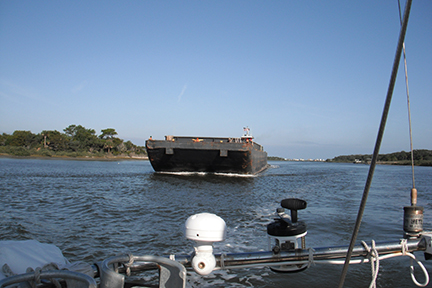
Offshore, ships are our nemesis. Sometimes we see their lights for hours without ever verifying what they are. Other times we have only minutes to tack or take other evasive actions. All this fuss and worry is caused by ships that are miles away from us, yet, in the ICW we have been passed so close by a tug pushing a barge that we could have shaken hands with the crew. And though these operators are more likely to respond to their radio than the crews of ships offshore, they are no less scary when you round a bend to see them yards, not miles, in front of you.
The wakes these giants (and motor yachts) throw in the confines of the Intracoastal aren’t like an ocean swell that you can lazily drift over and become accustomed to. Instead, they are violent assaults, unexpectedly shaking up your otherwise relatively calm world.

Our vacation cruise has been a challenge that we hadn’t quite expected. But it is new adventures like these that keep us sailing ever onward, never getting bored with the lifestyle. We are gunkholing and exploring the nooks and crannies that aren’t even named on our charts, and growing to love our little AS-29. It may not be as easy as we had hoped, but we are even enjoying the challenges. If only the water in the ICW were blue enough to see the dolphins.
Connie McBride, her husband and their three sons sailed away on their 34-foot Creekmore in 2002. Since then they have explored much of the Caribbean. You can read about their adventures in Panama in her new book, Eurisko Sails West: A Year in Panama, available at Amazon and on www.simplysailingonline.com.

